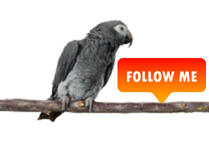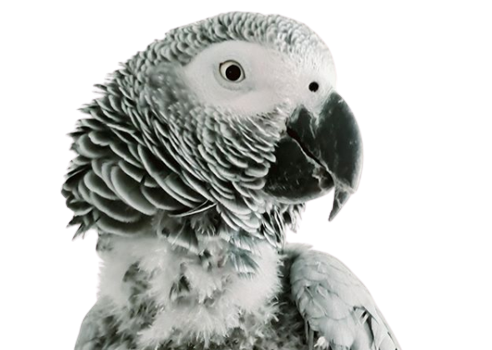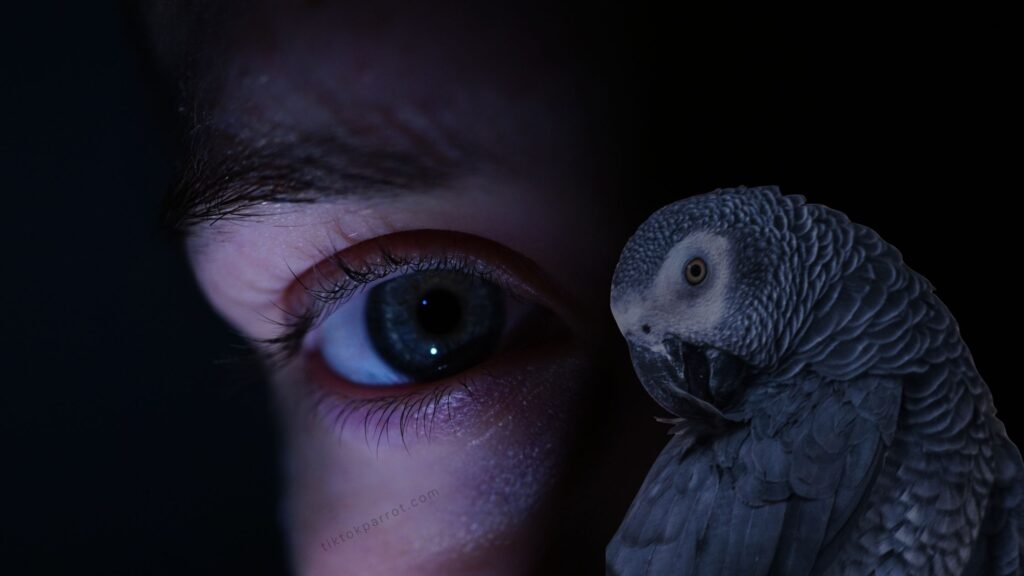If you’ve ever had the pleasure of spending time with an African Grey Parrot, you probably noticed that they’re not just all talk (though, trust me, they do love to chat!). These birds are incredibly meticulous about their grooming, and that’s not just because they want to look good for you.
Nope, their grooming habits say a lot about their health. So, if you’ve ever caught your parrot fluffing its feathers or chewing on its toes, let’s break down what’s really going on behind the scenes.
Table of Contents
Discover the fascinating world of African Grey parrot grooming! Learn about their unique behaviors, the importance of foot health, and tips for keeping your feathered friend healthy and happy.
In today’s comprehensive guide, we’ll dive into the fascinating world of African Grey parrot grooming, exploring their unique behaviors and how they contribute to their overall health.
Understanding African Grey Parrot Grooming
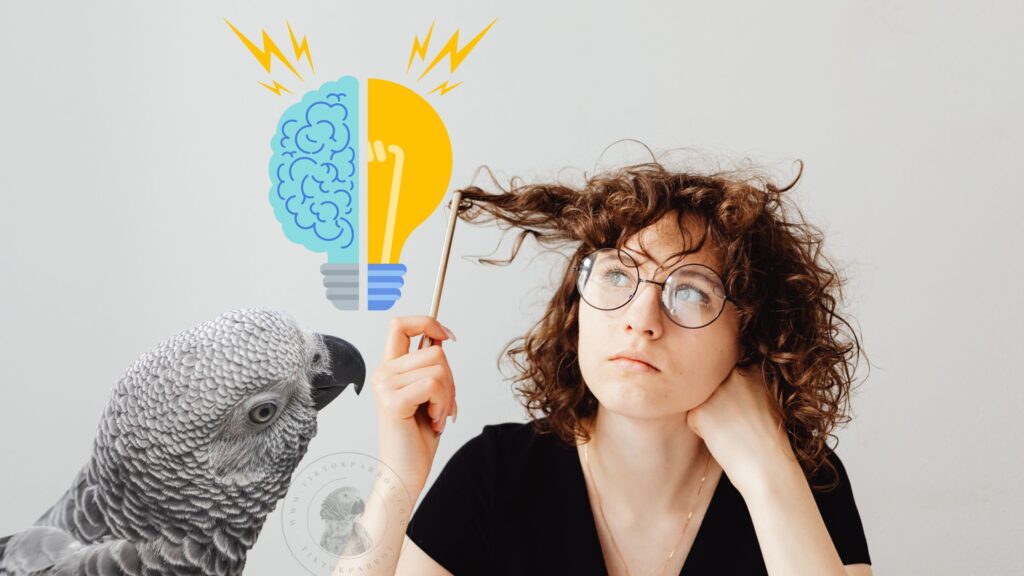
Grooming is a natural instinct for African Grey parrots. It’s more than just a way to keep their feathers looking neat; it’s a vital part of their self-care routine. By preening and plucking, they remove dirt, parasites, and damaged feathers, ensuring their plumage remains healthy and functional.
Feather Preening – The Ultimate Parrot Spa Day
Preening is the most common grooming habit you’ll notice in your African Grey. It’s basically the bird equivalent of a spa day, except they don’t have to book an appointment. Preening is when your parrot uses its beak to clean and align its feathers. They’ll even take the time to spread natural oils from a gland near their tail across their feathers. This not only keeps their plumage looking sleek and shiny but also waterproof and flexible.
Now, what does this mean for their health? Well, if your Grey is preening regularly, it’s a sign they’re feeling good. It shows they care about their appearance and comfort—like when we finally get around to organizing our desk (you know the feeling!). But, if you notice excessive preening, missing patches of feathers, or a complete lack of preening, it’s time to worry. That could indicate stress, illness, or even boredom.
The Importance of Preening
Preening is the most common grooming behavior among African Greys. Using their beaks and feet, they carefully inspect and tidy their feathers. This process helps to:
- Remove dirt and debris: Feathers can accumulate dirt, dust, and other particles from their environment. Preening helps to keep them clean and free from contaminants.
- Distribute natural oils: African Grey parrots have a gland near their tail called the uropygial gland. This gland produces a natural oil that helps to waterproof and condition their feathers. Preening helps to distribute this oil evenly throughout their plumage.
- Strengthen social bonds: Preening is often a social activity, especially among paired birds. By preening each other, African Greys can strengthen their bond and show affection.
Quick Tip: If your parrot is going through a molt (yes, they shed feathers just like dogs shed fur), it’s normal for them to preen a little more often. Molting can be itchy business!
Foot Grooming – Yes, Those Feet Need Love Too!

When was the last time you took a good look at your African Grey’s feet? They may not be the prettiest things, but their feet are powerful tools for climbing, grasping, and, yes, grooming. African Greys will often chew on their feet or nibble between their toes. Don’t worry; they’re not trying to eat themselves! This is just a part of their grooming routine.
But here’s where things get interesting. The structure of an African Grey’s feet is pretty unique. They have what’s called zygodactyl feet—two toes pointing forward and two pointing backward. These are designed for climbing and grasping objects like a pro! Imagine them as little birdy rock climbers, always equipped with the perfect gear for scaling the walls of their cage or perching on your shoulder.
However, those strong feet are susceptible to foot health issues, especially if your bird doesn’t have the right perches. A common issue is “bumblefoot,” where sores develop due to too much pressure on their feet. Always ensure they have a variety of perch sizes and materials to stand on to keep those toes healthy!
Foot Health: A Vital Component of Grooming
While grooming primarily focuses on feather maintenance, foot health is equally important. African Greys use their feet for climbing, grasping objects, and interacting with their environment. Healthy feet are essential for their overall well-being.
Foot Structure
African Grey parrots have zygodactyl feet, meaning they have two toes pointing forward and two pointing backward. This unique arrangement provides excellent grip and stability, allowing them to climb and perch with ease.
Foot Care
To maintain healthy feet, it’s important to:
- Provide suitable perches: Ensure your African Grey has a variety of perches of different sizes, shapes, and textures. This will help to keep their feet strong and prevent foot injuries.
- Check for foot problems: Regularly inspect your bird’s feet for any signs of injury, infection, or abnormalities. If you notice any issues, consult with an avian veterinarian.
- Keep their feet clean: Gently clean your bird’s feet with warm water and a mild, bird-safe disinfectant. This will help to prevent infections and keep their feet healthy.
Common Foot Health Issues and Treatments
Some common foot health problems that African Greys may experience include:
- Bumblefoot: This is a painful condition caused by pressure sores on the feet. It can be treated with appropriate wound care and veterinary intervention.
- Nail overgrowth: If nails become too long, they can interfere with walking and cause discomfort. Regular nail trims are essential.
- Infections: Infections can occur if the feet are not kept clean or if there are injuries. Antibiotics may be necessary to treat infections.
Quick Tip: If your parrot starts obsessively chewing its feet or limping, check for redness, swelling, or sores. These are signs of foot problems that need attention, preferably from an avian vet.
Beak Grinding – Time to Relax!
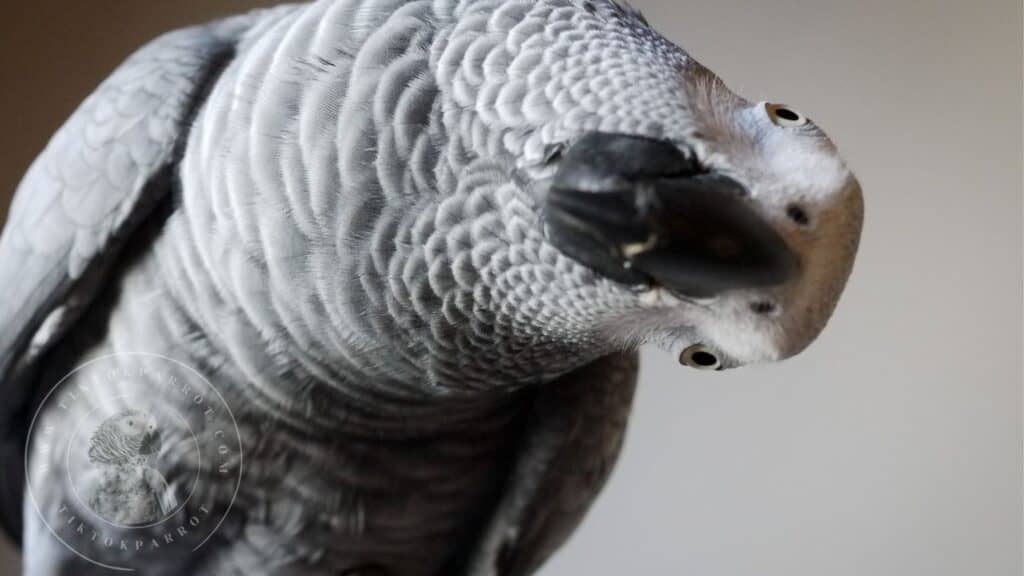
Ever caught your African Grey grinding its beak, especially right before bedtime? It’s like their version of purring. Beak grinding is a sign that they’re content and winding down for the day. This behavior helps them keep their beak in shape—kind of like filing their nails.
However, if your bird’s beak looks overgrown or misaligned, or if they stop grinding altogether, there could be an issue. Beak problems often stem from poor diet or underlying health concerns. But as long as that little grinding noise is happening, you can rest easy knowing your Grey is in good shape.
Bathing – Splash Zone Ahead!
Some African Grey Parrots love a good bath, while others act like you’ve just suggested the most ridiculous idea ever. Bathing is a natural part of their grooming routine. Whether they enjoy a gentle misting from a spray bottle or a dip in a shallow bowl of water, baths help them keep their feathers clean and soft.
If your parrot avoids bathing, it could mean they’re not feeling well, or maybe they’re just not in the mood (can you blame them?). Either way, offering regular bathing opportunities is essential for their overall health.
Quick Tip: Don’t use soap when bathing your bird. Their feathers produce natural oils that soap can strip away, and that’s no bueno for their health.
Nail and Beak Maintenance – Manicure Time!
Much like us, African Greys’ nails and beaks grow continuously. In the wild, they naturally wear down their nails and beak by climbing, foraging, and using them to break open tough nuts. In captivity, they don’t always have the chance to do this, so it’s up to us to make sure they stay at a healthy length.
You’ll need to keep an eye on those talons and trim them when necessary. And beak maintenance? Well, your bird will handle most of that through grinding and chewing on toys. But if their beak starts looking too long or cracked, a trip to the vet might be in order.
Feather Plucking – When Grooming Goes Too Far

Uh-oh, here’s where things can get tricky. If your African Grey starts plucking out its own feathers, it’s a big red flag. Feather plucking can be caused by stress, boredom, illness, or even malnutrition. Sometimes, it’s behavioral, and other times, it’s a medical issue.
If you notice your bird starting to pluck, it’s time to investigate. Has anything in their environment changed? Are they getting enough mental stimulation? Are they on a healthy diet? Feather plucking is your parrot’s way of telling you something’s wrong, so don’t ignore it!
The Role of Plucking
Plucking is another important grooming behavior. African Greys may pluck their feathers for various reasons, including:
- Stress or anxiety: Excessive plucking can be a sign of underlying stress or anxiety. If your African Grey is plucking excessively, it’s important to address the root cause of their stress.
- Nutritional deficiencies: Sometimes, plucking can be a symptom of a nutritional deficiency. Ensure your bird is receiving a balanced diet that meets their specific needs.
- Hormonal imbalances: Hormonal imbalances can also contribute to plucking behavior. If you suspect a hormonal issue, consult with an avian veterinarian.
Quick Tip: Toys and foraging activities can help combat boredom and reduce the likelihood of feather plucking. Also, make sure your Grey gets plenty of social interaction!
How Grooming Reflects Their Diet
What your African Grey eats directly affects how well they groom. A diet rich in fruits, vegetables, and high-quality pellets ensures they have the nutrients needed for shiny feathers, a strong beak, and healthy skin. If your parrot’s feathers start to look dull or scruffy, it could be a sign they’re not getting the right nutrition.
Adding foods rich in Vitamin A (like sweet potatoes and carrots) can do wonders for their overall health and grooming habits. It’s like feeding your parrot a five-star meal instead of fast food!
My Thoughts: Keep an Eye on Those Grooming Habits
In the end, your African Grey’s grooming habits are more than just about looking good. They’re a window into their health and well-being. From preening to foot grooming, each behavior tells you something about how they’re feeling. If you notice anything unusual, don’t brush it off. Your bird may be trying to send you a message!
Grooming is a natural and essential part of an African Grey parrot’s life. By understanding their grooming behaviors and providing appropriate care, you can help to ensure their physical and emotional well-being. If you have any concerns about your African Grey’s grooming habits or foot health, don’t hesitate to consult with an avian veterinarian.
And remember, the best way to support your African Grey’s grooming habits is by giving them a nutritious diet, plenty of mental stimulation, and lots of love.
Have you noticed any interesting grooming habits in your parrot? Share your experiences in the comments below! And if you have any tips or tricks, we’d love to hear them!
If you liked this blog, please share it with your family and friends who might also find it helpful. If you love African Greys, join our community of Grey owners! You can meet other owners, share tips and learn from each other.
You might like to read these as well 🙂
For more useful content about African grey parrots, you can subscribe my site with your email to get notification upon publishing a new blog, the subscribe box you can see on the right side of this page. Also if you get an alert on your web browser while browsing my site, allow it and that will also give you an alert whenever I publish a new blog. 🙂
Stay safe and much love!

